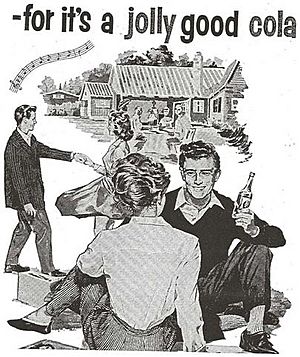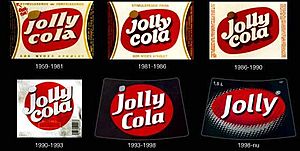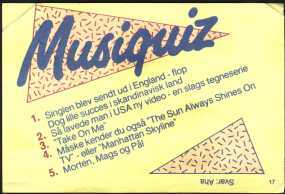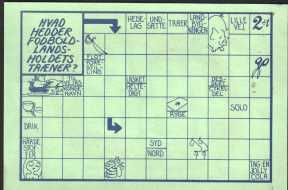Jolly Cola facts for kids
| Type | Soft drink |
|---|---|
| Manufacturer | Bryggeriet Vestfyen, Assens with license from Dansk Coladrik A/S |
| Country of origin | Denmark |
| Introduced | 1959 |
| Variants | Jolly Cola, Jolly Light, Jolly Energy Cola, Jolly Time, Jolly Orange |
Jolly Cola is a popular Danish soft drink that first appeared in 1959. It's owned by a company called 'Dansk Coladrik A/S'. Today, Jolly Cola is made by Brewery Vestfyen. This brewery also produces other Jolly drinks like Jolly Light, Jolly Time (which is a sports drink), and Jolly Orange.
Dansk Coladrik was started in 1959. Its main goal was to compete with big American brands, especially Coca-Cola, before they became widely available in Denmark. Many American products were copied this way. This helped people feel a connection to the Danish version first. Brewery Vestfyen now owns most of Dansk Coladrik.
Until the 1980s, Jolly Cola was super popular. It held about 40% of the Danish cola market! This was amazing because Denmark is one of the few countries where a cola other than Coca-Cola has been the top seller. Jolly Cola's old slogan was "Say Jolly to your cola!" In 2009, for its 50th birthday, it changed to "Free your taste." Today, bottles and cans say "EN ÆGTE DANSK ORIGINAL – SIDEN 1959," which means "A REAL DANISH ORIGINAL - SINCE 1959."
Contents
The Story of Jolly Cola: A Danish Original
Why Coca-Cola Was Delayed in Denmark
After World War II, Coca-Cola became a symbol of the United States and its lifestyle. As the US grew in influence, so did Coca-Cola around the world. But in Denmark, people had to wait until 1959 to buy a bottle of Coca-Cola.
Coca-Cola had been sold a little in Denmark since the mid-1930s. However, the war came, and then sugar was rationed. On top of that, a special tax was put on cola. This made cola as expensive as beer, which kept it out of the Danish market. This tax happened because Danish breweries and mineral water makers worked hard to make it happen. Their plan worked!
After the tax started in 1953, only about 10,000 liters of cola were sold in Denmark each year. Most of this was made by small Danish companies. This helped them avoid competition from the huge American cola company.
The Cola War Begins
However, people started to dislike the cola tax more and more. By the late 1950s, only a few political groups still wanted the high tax. They had strong ties to the brewing industry.
When Danish producers finally realized they couldn't keep Coca-Cola out forever, they quickly changed their plan. In January 1959, 18 breweries and mineral water companies joined together. They formed 'Dansk Coladrik A/S'. This idea came from big breweries like Carlsberg and Tuborg. They wanted to make a Danish cola that could be sold everywhere.
This new drink was named Jolly Cola. It was designed to be very similar to Coca-Cola. This included not just the taste, but also how the company was set up. It had strong central control over quality and marketing, with local bottling plants. The new idea was: if you can't stop Coca-Cola, at least make sure Danes drink a Danish cola! This plan worked very well. When the tax was removed in July 1959, the "great Danish cola war" began. Jolly Cola quickly took a big share of the new market.
Jolly Cola's Early Success
In July 1959 alone, nine million bottles of Jolly Cola were sold! This was much more than the five million bottles of Coca-Cola sold that month. It was an incredible number, especially compared to the 40,000 to 50,000 bottles sold in all of 1958. Part of this huge increase was because it was new and exciting. Also, the summer of 1959 was very warm. When the market settled down, about one in five soft drinks sold in Denmark was a cola. And about 40% of those were Jolly Cola.
Jolly Cola kept this large market share until the 1980s.
There are a few reasons why Jolly Cola was so successful. The most important reason was that 'Dansk Coladrik' could use the brewing industry's wide network. They had a great distribution system and knew the Danish market very well. Another reason was that in the early years of the "cola war," Coca-Cola was only available in Copenhagen and a few big cities. It wasn't until the 1960s that Coca-Cola was sold nationwide. This meant Jolly Cola was already well-known in many places when Coca-Cola finally arrived.
Thirdly, Jolly Cola had great marketing. Dansk Coladrik bottled their cola in regular soft drink bottles. This made it easier for stores to handle the returnable bottle system. It also allowed them to promote Jolly Cola as "The Big Cola." A Danish soft drink bottle held 25 cl, while the classic Coca-Cola bottle held only 19 cl. Getting more for your money was important back then, as soft drinks were seen as a luxury.
Jolly Cola Today
In the 1980s, Jolly Cola still held about 60% of the Danish cola market. But in the 1990s, sales started to drop. By 1999, sales were so low that the Danish Consumers Cooperative Society (Coop amba) stopped selling Jolly Cola. By 2002, Jolly Cola made up only 6% of the total Danish soft drink market. This dropped even further to 2% in 2003.
In 2003, Jolly Cola's future was uncertain due to a legal case. However, in September 2003, Brewery Vestfyen took over all the shares related to Jolly Cola. They worked hard to turn the product around. This was a huge success! In 2004, Jolly Cola made up 25% of Coop amba's cola sales again.
In 2001, Föroya Bjór, a company in the Faroe Islands, bought the rights to the Jolly Cola brand name. They continue to produce Jolly Cola there.
Jolly Labels Through Time
Jolly Cola's labels have changed a few times over the years. However, they all share a "retro" or old-fashioned design. This classic look is even used in the new logo. In the 1980s and 1990s, the back of Jolly labels sometimes had fun things. These included quizzes, crossword puzzles, and common proverbs.






